Gus Kenworthy Q&A: Prepping for X Games Oslo, nagging injuries, more

American freeskier Gus Kenworthy is having one of the best seasons of his career. The 2014 Olympic bronze medalist won the slopestyle event at the Dew Tour, the U.S. Grand Prix Halfpipe event, took double silver at the X Games in halfpipe and slopestyle and is a top contender going into the second X Games competition of the season in Oslo, Norway. The Big Air qualifications for skiers begin tomorrow, while the superpipe events will take place on Sunday.
Kenworthy has achieved all of his recent success on the heels of an injury that has put him on the fence of competing or pulling out of nearly every event this season. So Kenworthy strategically did not compete at multiple U.S. Grand Prix stops this season to ensure his ability to participate in his favorite event: Winter X Games.
Ryan Wallerson: You’re one of the only freeskiers who competes in all three disciplines—halfpipe, big air and slopestyle—why do you opt for all three?
Gus Kenworthy: I just like skiing all three disciplines so much that I’d have a very hard time choosing which one I would get rid of if I was going to focus on just one or two. I think each discipline has its own merit in my mind; each one has things that I like about it. I’ve also always competed in all three from when I was younger, so even though it can be a lot at this level, I’m used to it now. I don’t want to mess with the formula that’s worked so well for me.
Big Air at Fenway Park

Fenway Park’s Green Monster dressed up for the Polartec Big Air competition.
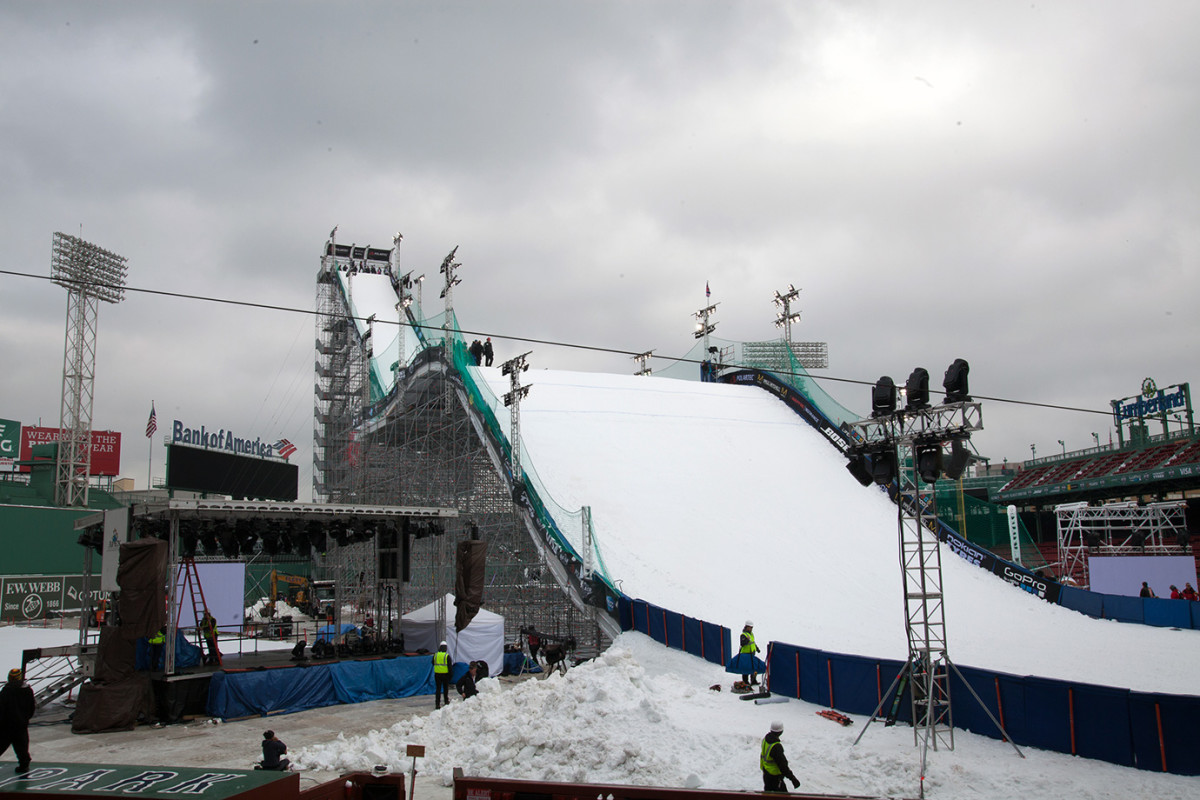
The 150-foot-ramp, which extended from home plate out to left center field, took nearly three weeks to build and was 10 feet taller than originally anticipated.
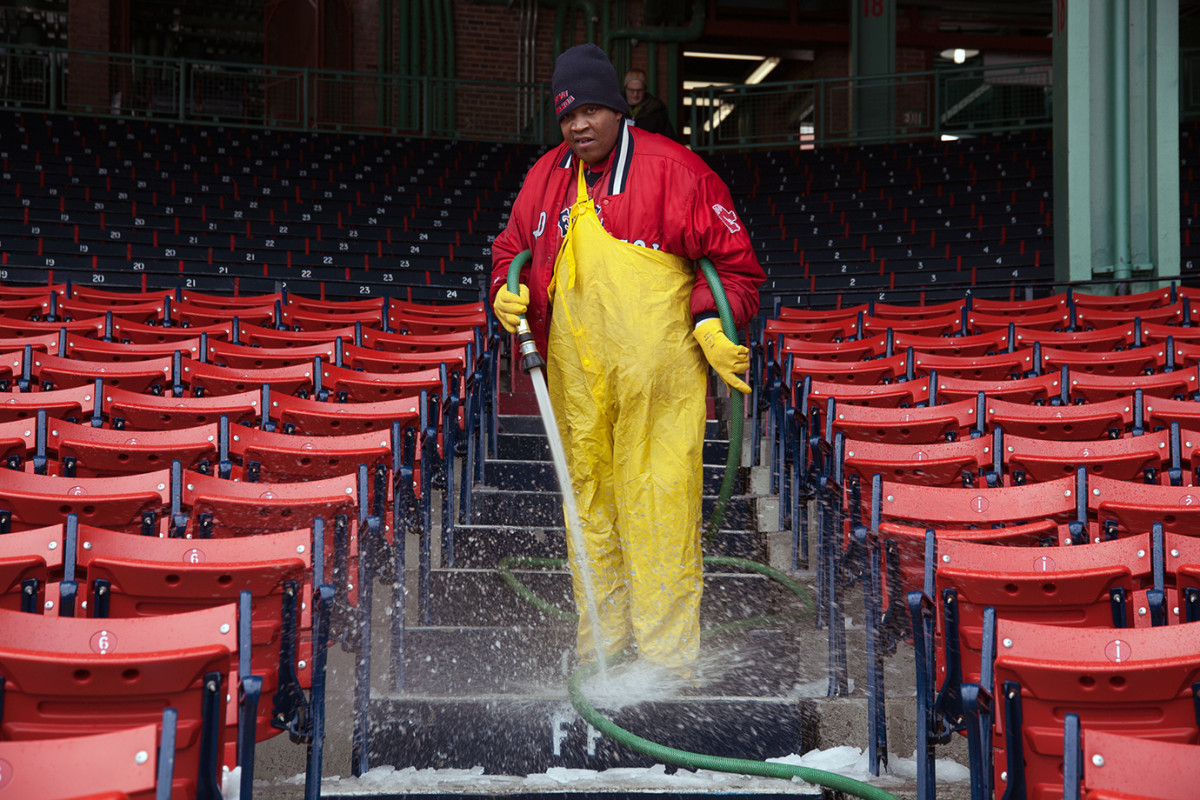
A member of the Fenway Park grounds crew prepares the lower bowl seating for the big crowds expected for the two-night event.
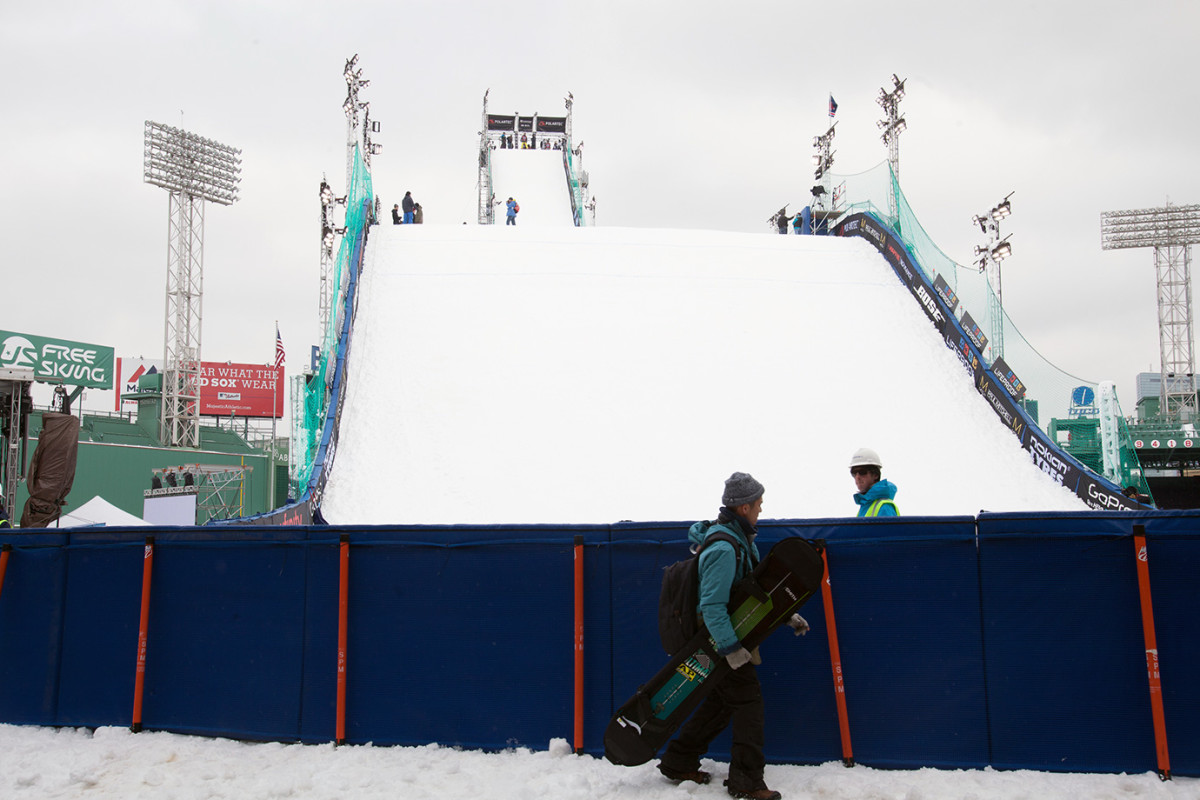
Athletes practice on the ramp, sizing up the man-made jump and figuring out their plans for the coming event.
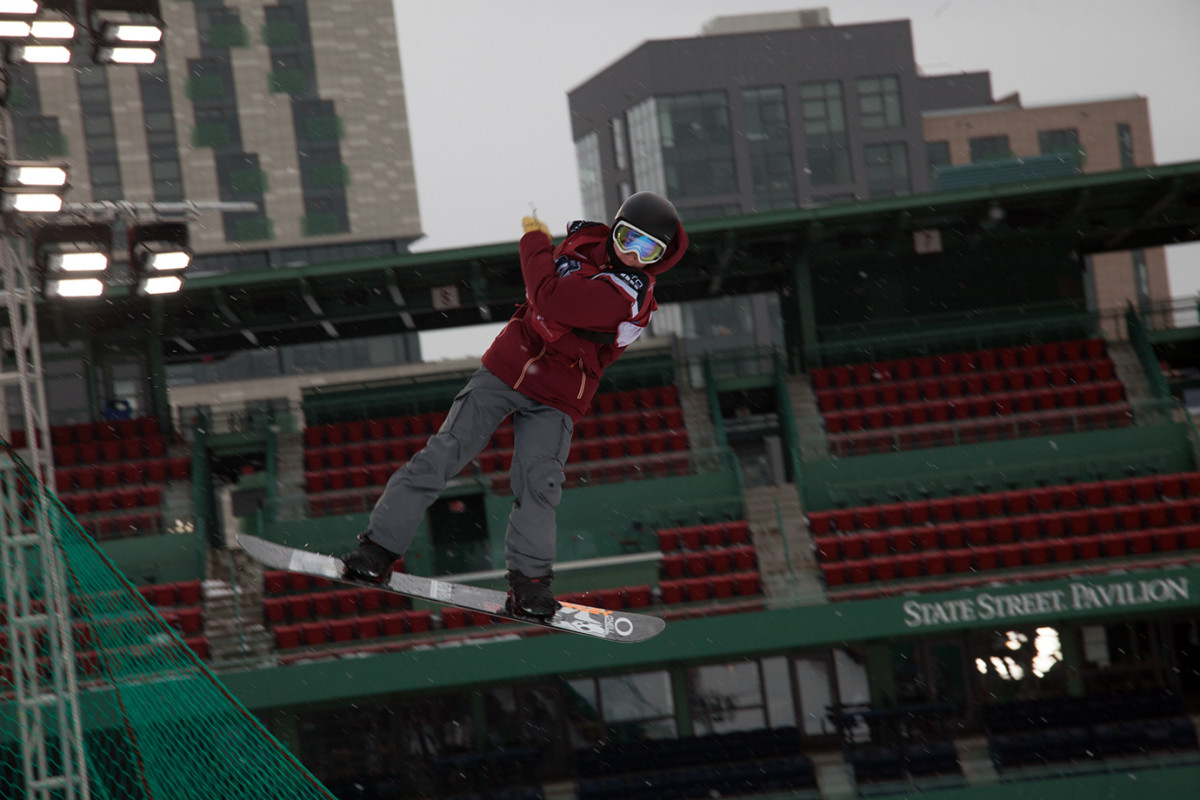
A snowboarder tests the ramp, catching air in front of a very unfamiliar backdrop for a ski or snowboard event.
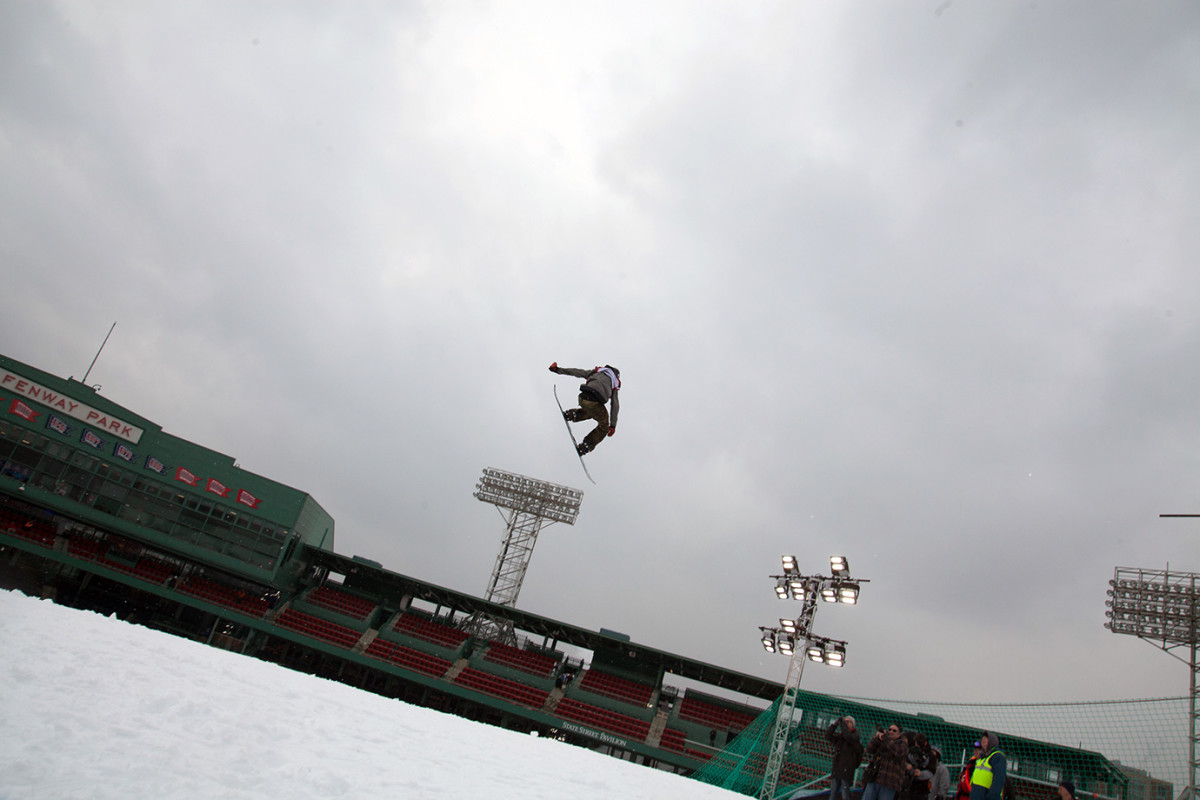
A snowboarder rises above the iconic Fenway Park sign during Polartec Big Air practice.
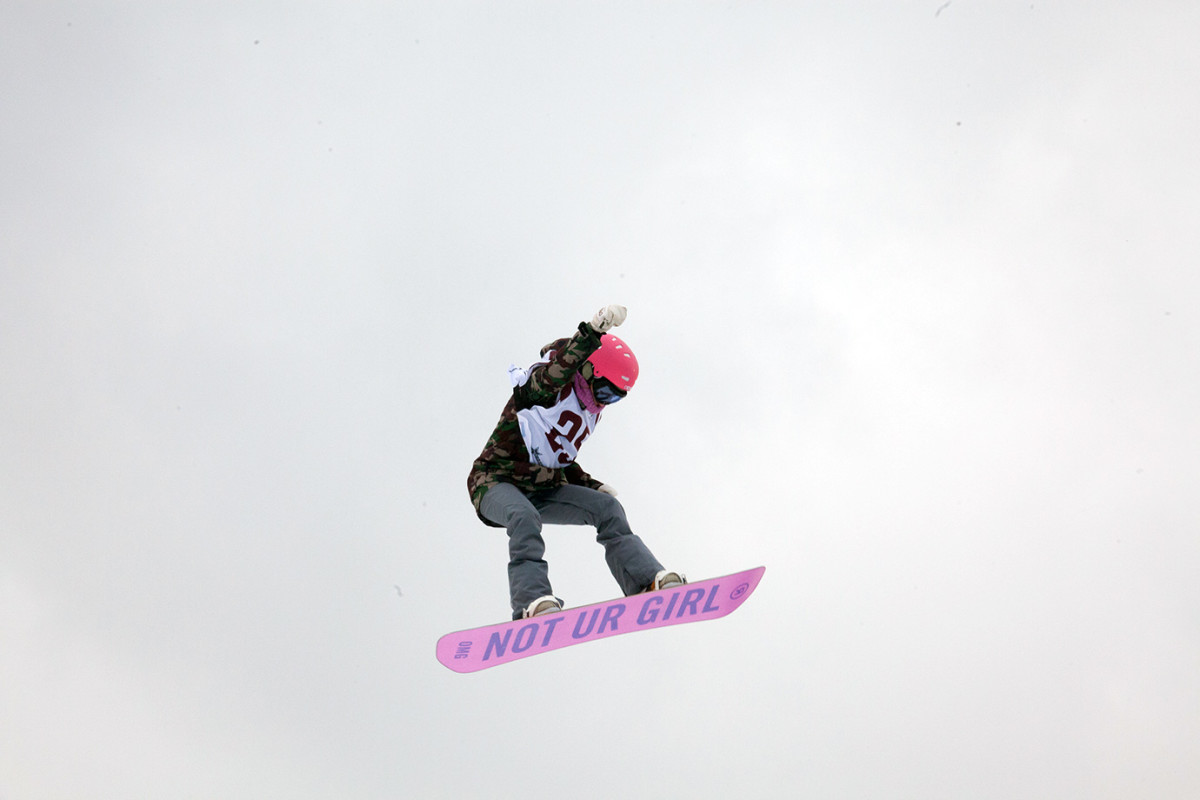
Just like this year’s X Games Olso Big Air competition, the Big Air competition at Fenway was open to female snowboarders and skiers. The big air event was added to the women’s World Cup and U.S. Grand Prix seasons in 2015.
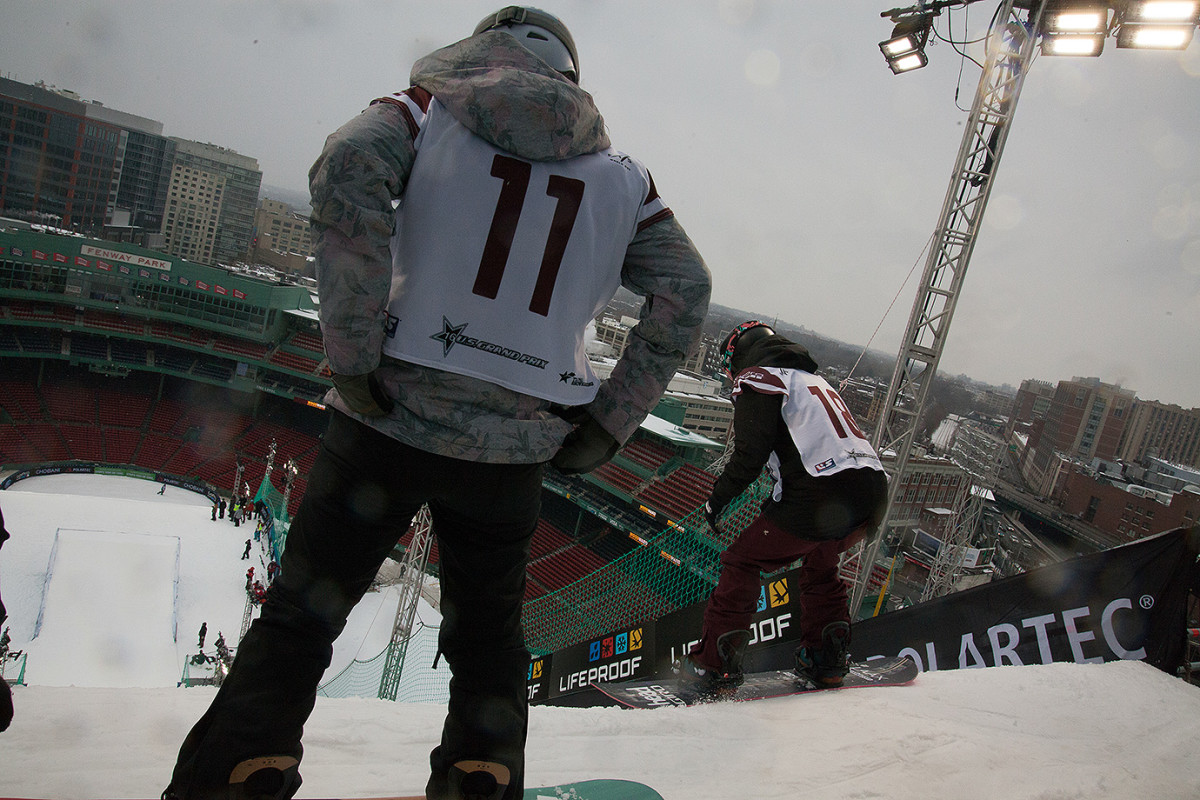
A couple of riders sized up the 150-foot jump from the very top during practice.
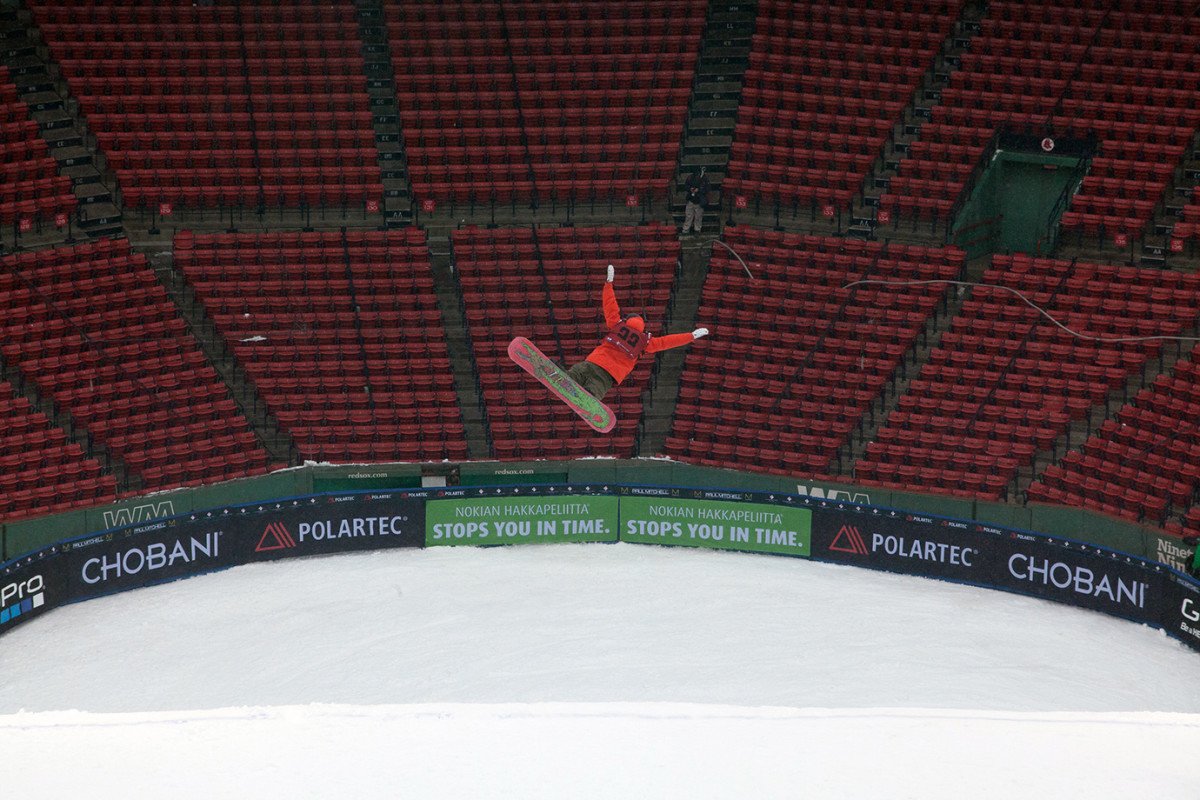
The athletes had a lot of fun with the novelty of holding a big air event in Boston’s Fenway Park.
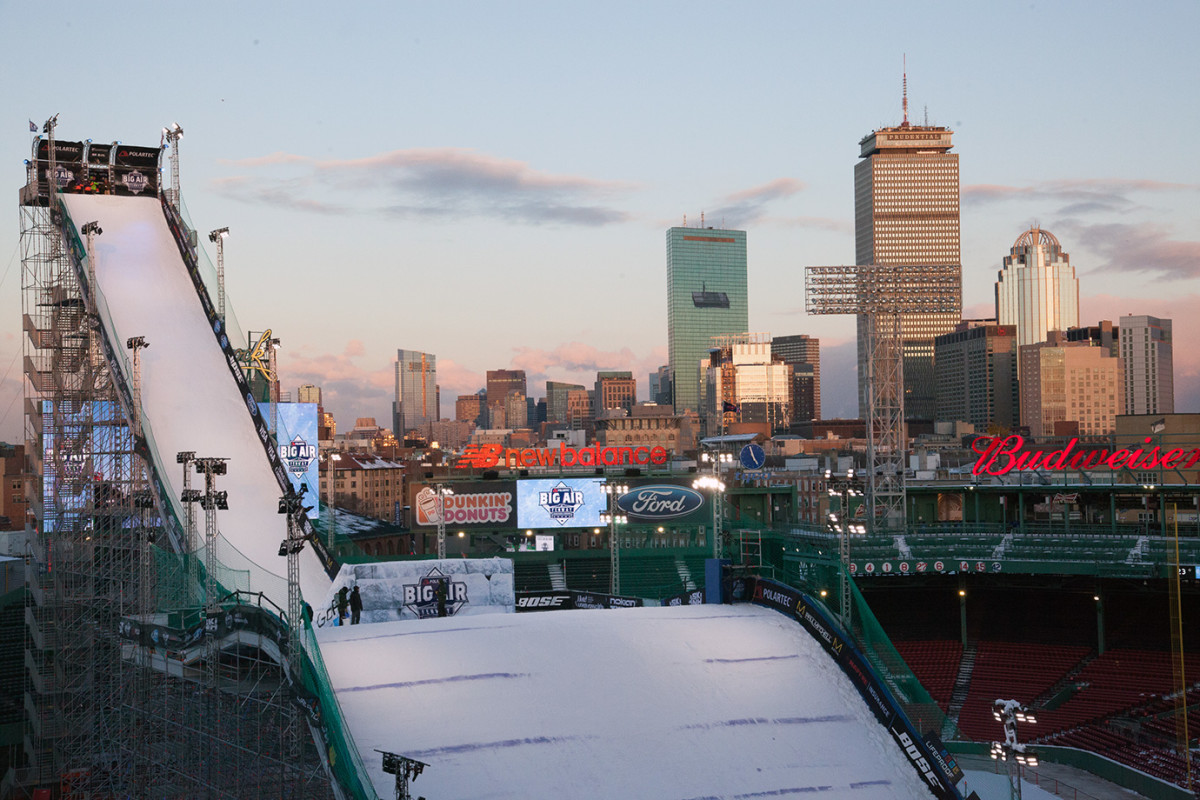
The Big Air ramp as the sun set over Fenway Park.
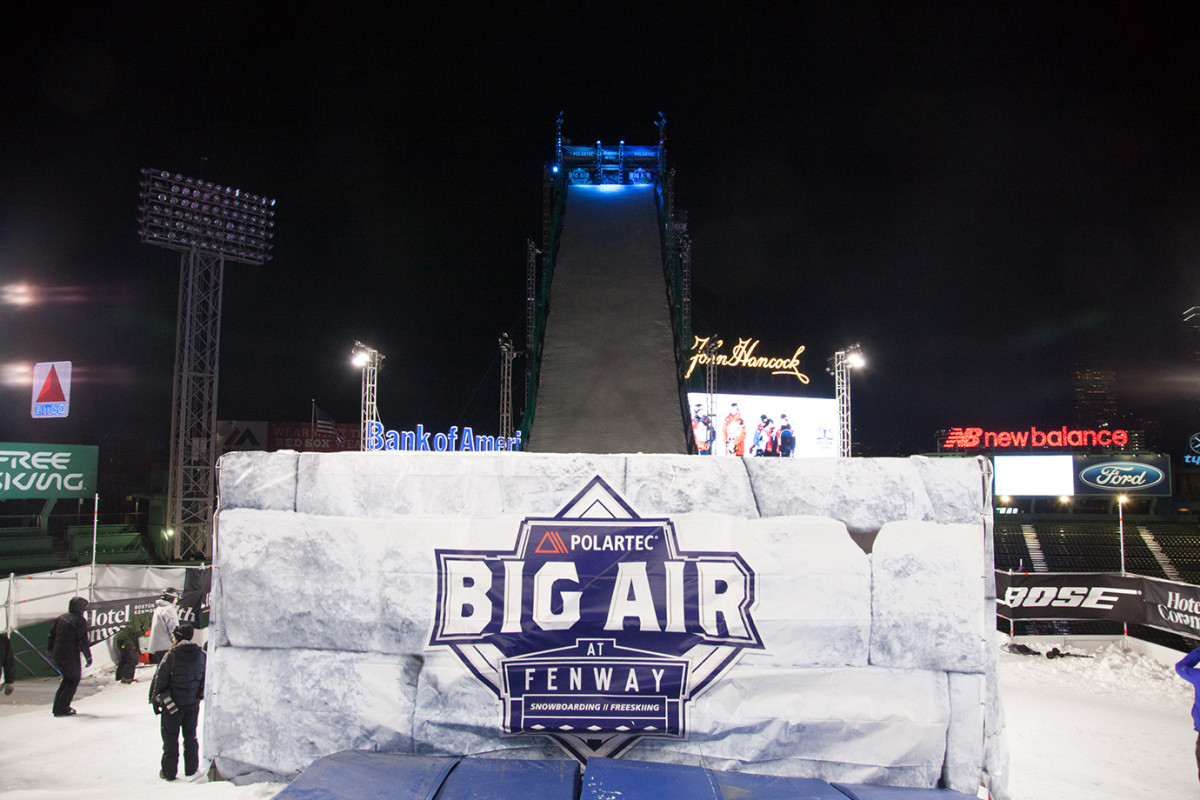
The Big Air ramp from the launch base as the snowboarders are introduced at the snowboarding competition.
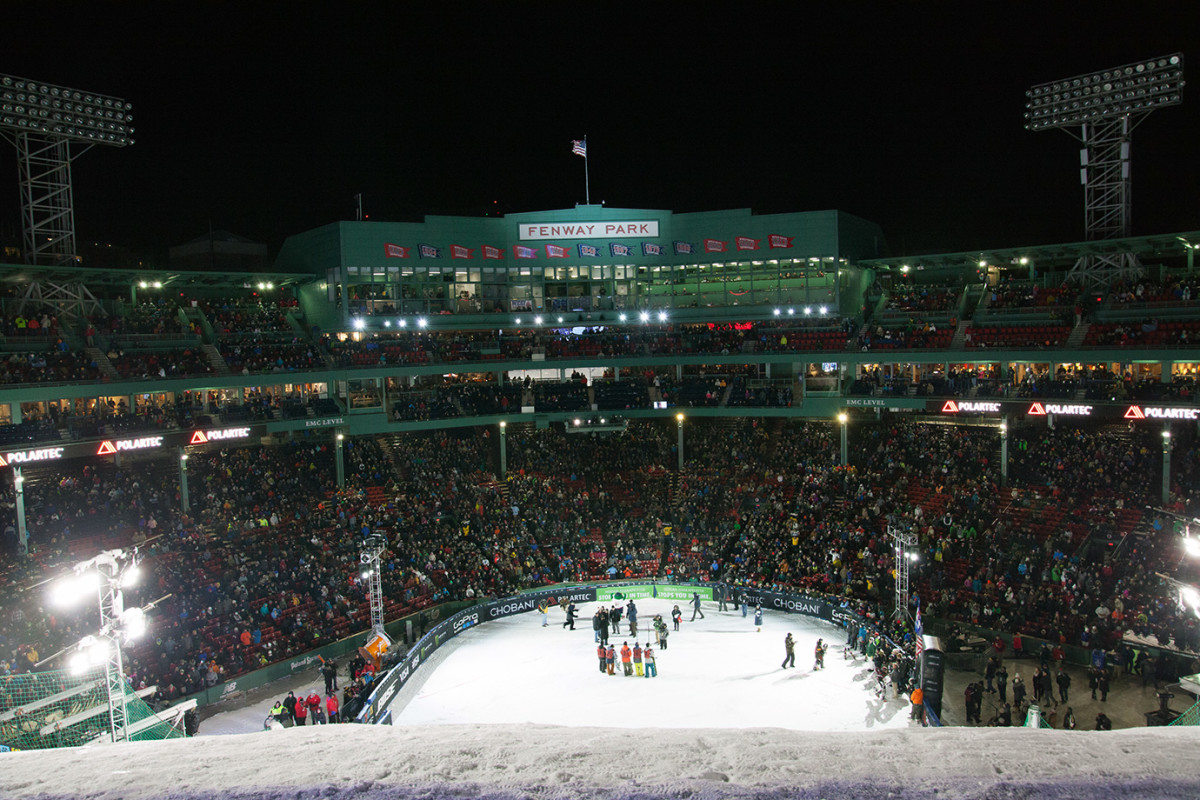
The crowd at Fenway Park for the snowboard Big Air competition, seen from the launch pad level of the jump.
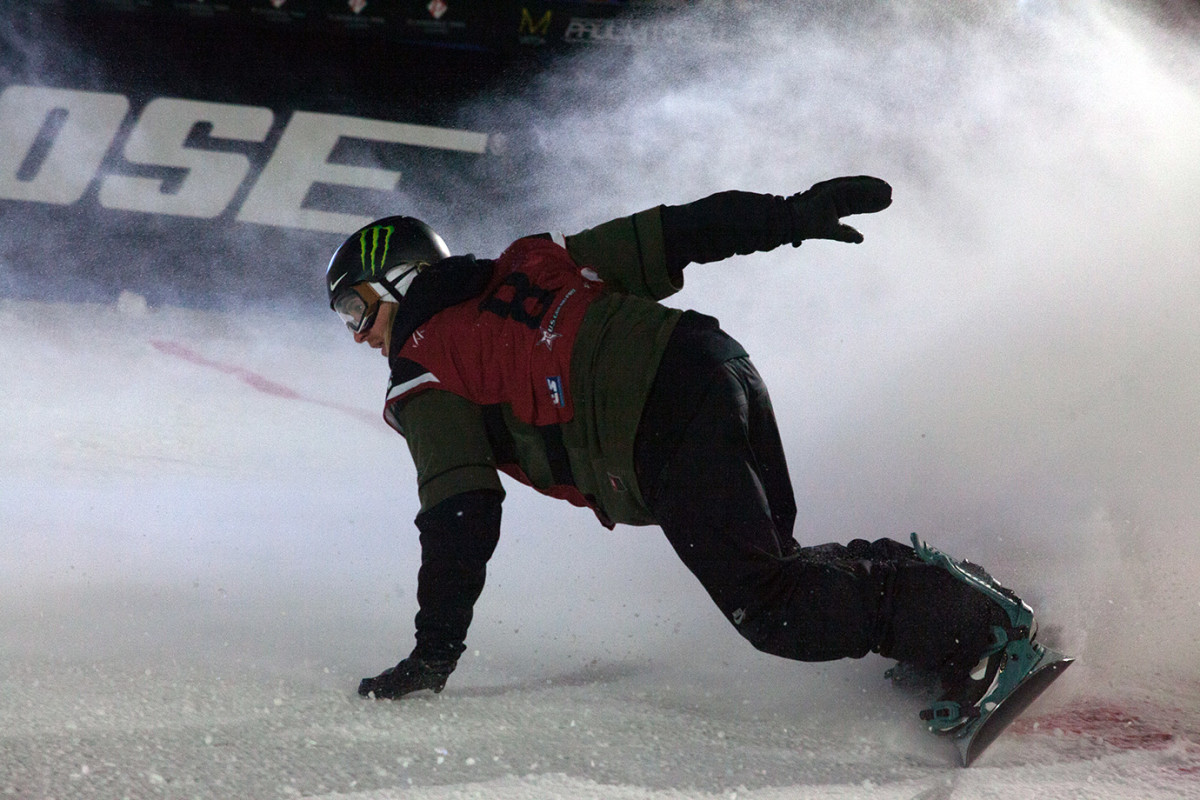
Michael Schaerer slides safely across the home plate drawn at the base of the jump during the first round of the Big Air snowboard final.
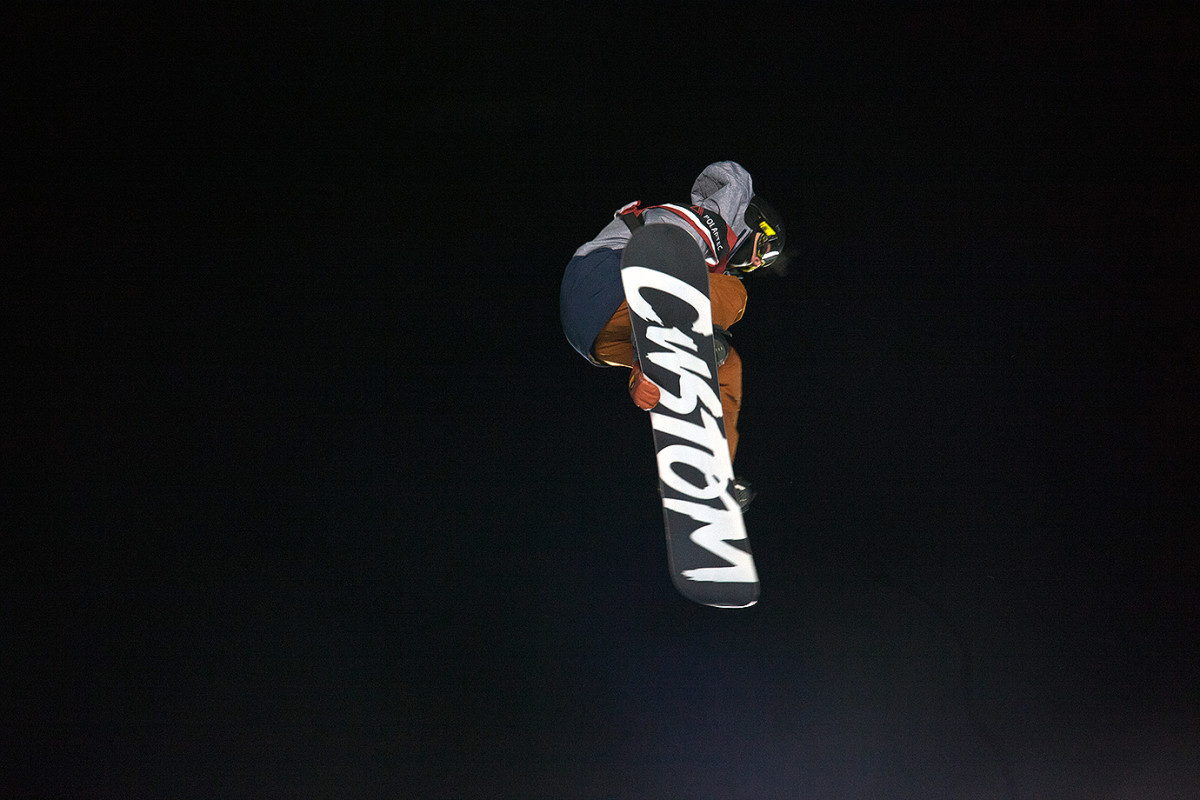
Silver medalist Michael Ciccarelli goes airborne during the second round of the snowboard Big Air competition.
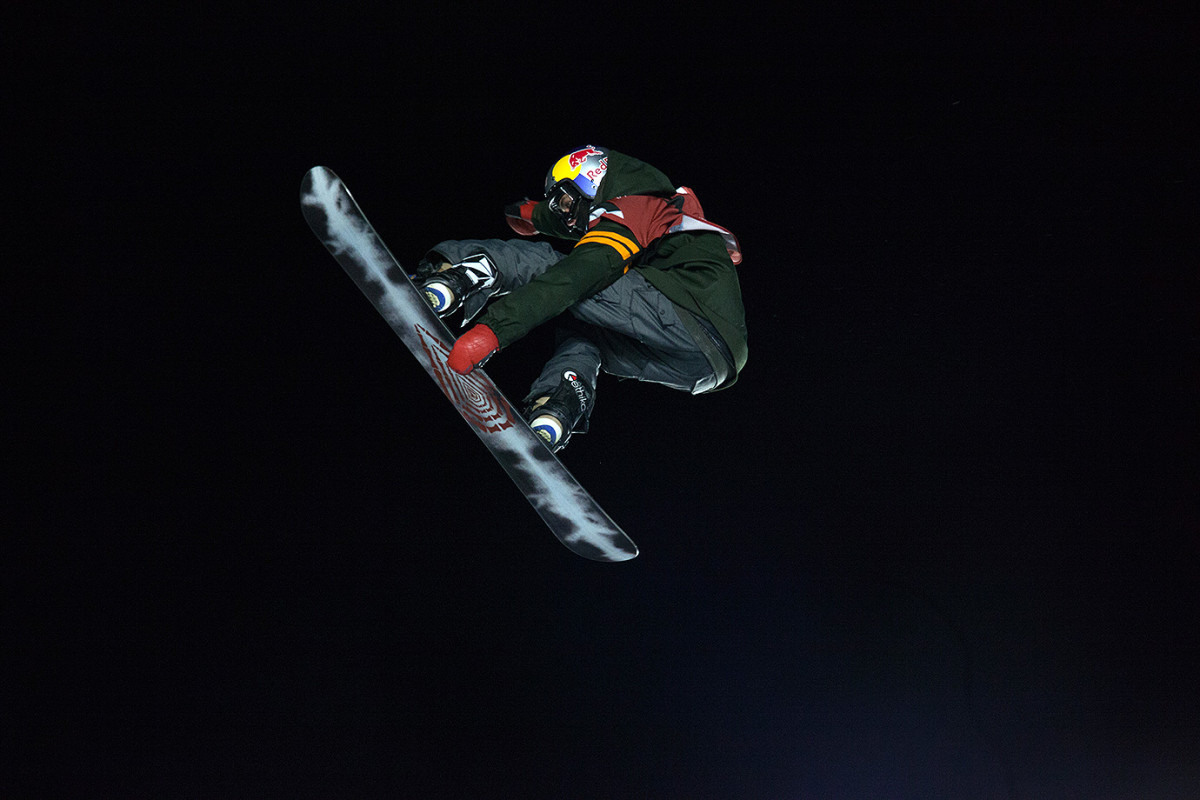
Lyon Farrell, the youngest member of the Big Air snowboard final, takes flight during the second round.
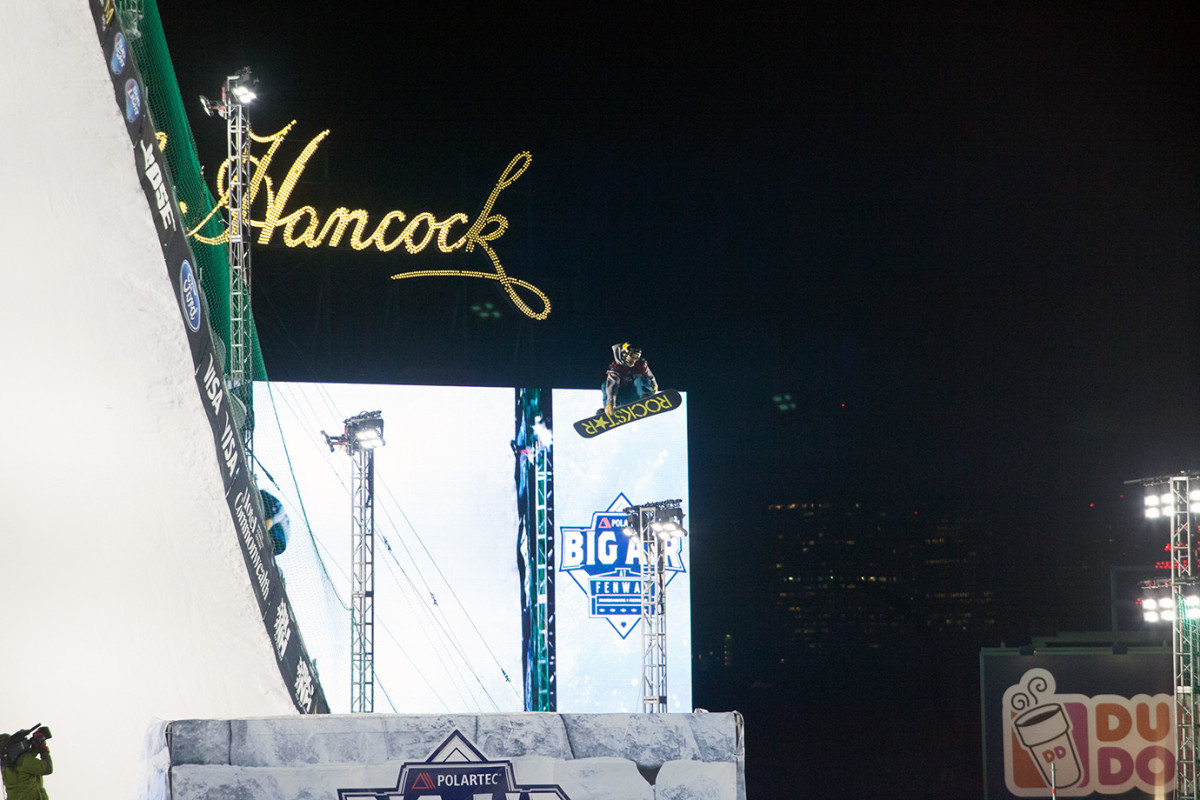
Charles Guldemond, "Chuck G" for short, mid-flight in the second round of the snowboard final.
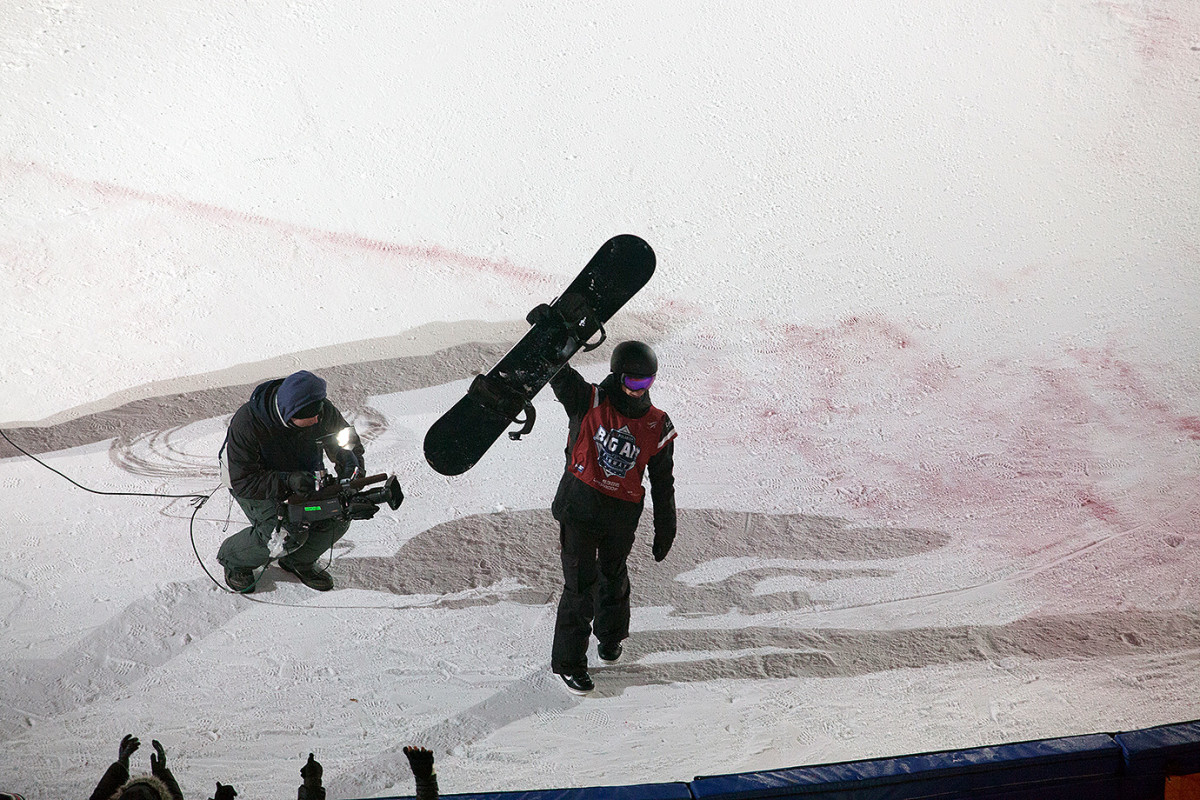
Max Parrot acknowledges the Fenway crowd after completing his second run, which earned him the top score of the competition.
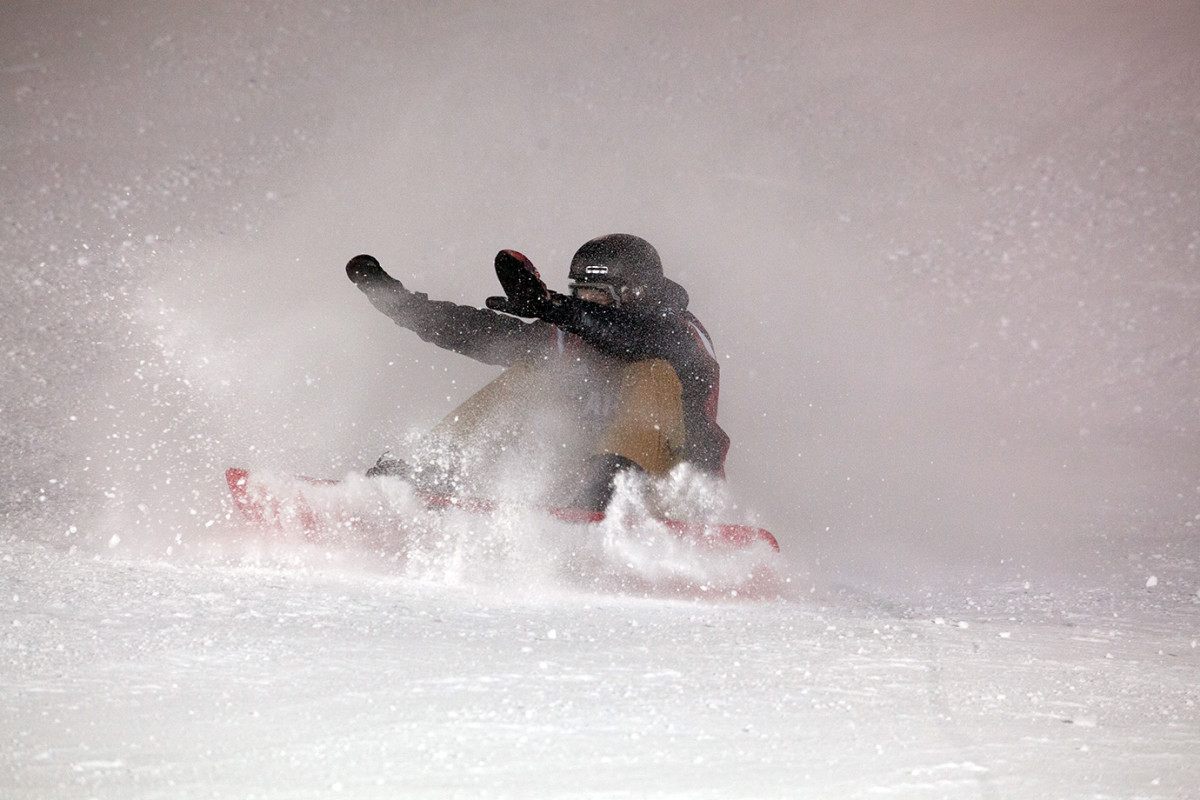
The base of the jump ended quickly after home plate; many riders opted to speed check by taking a seat after their runs were deemed completed to avoid hitting the wall.
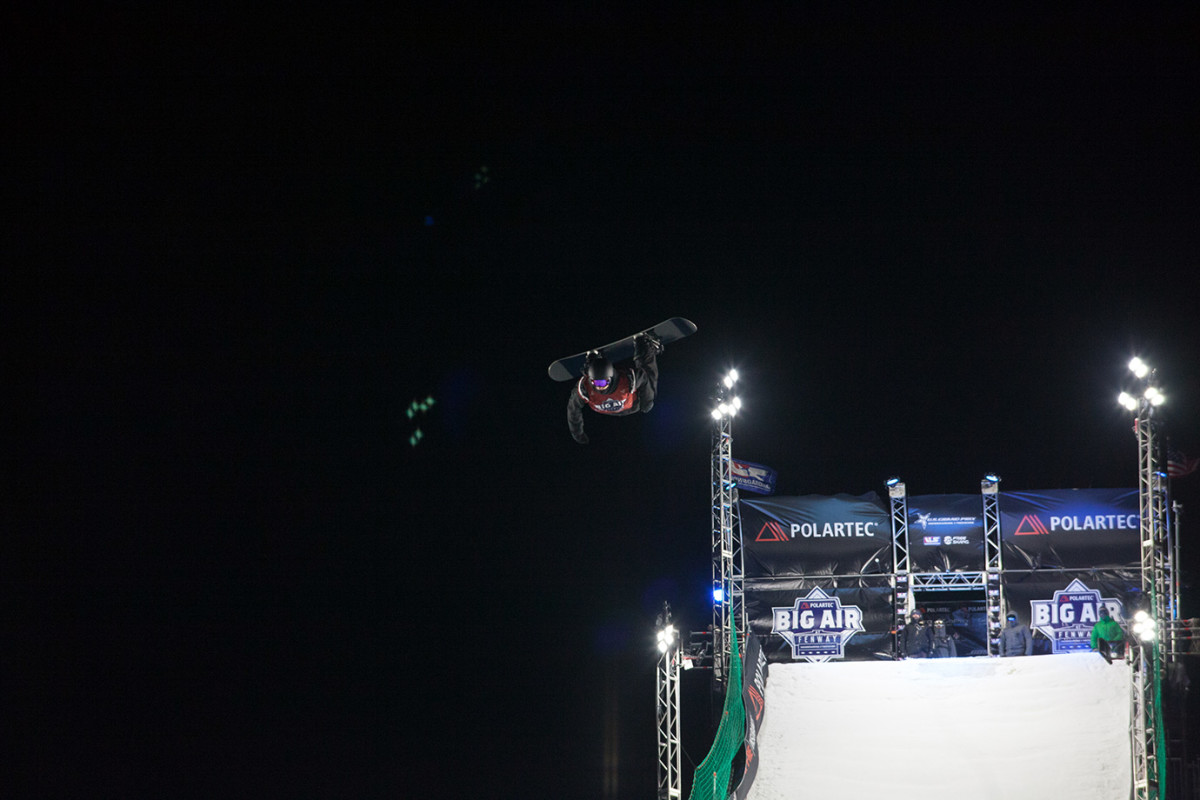
Max Parrot flies over Fenway Park during his third run and the final run of the night.
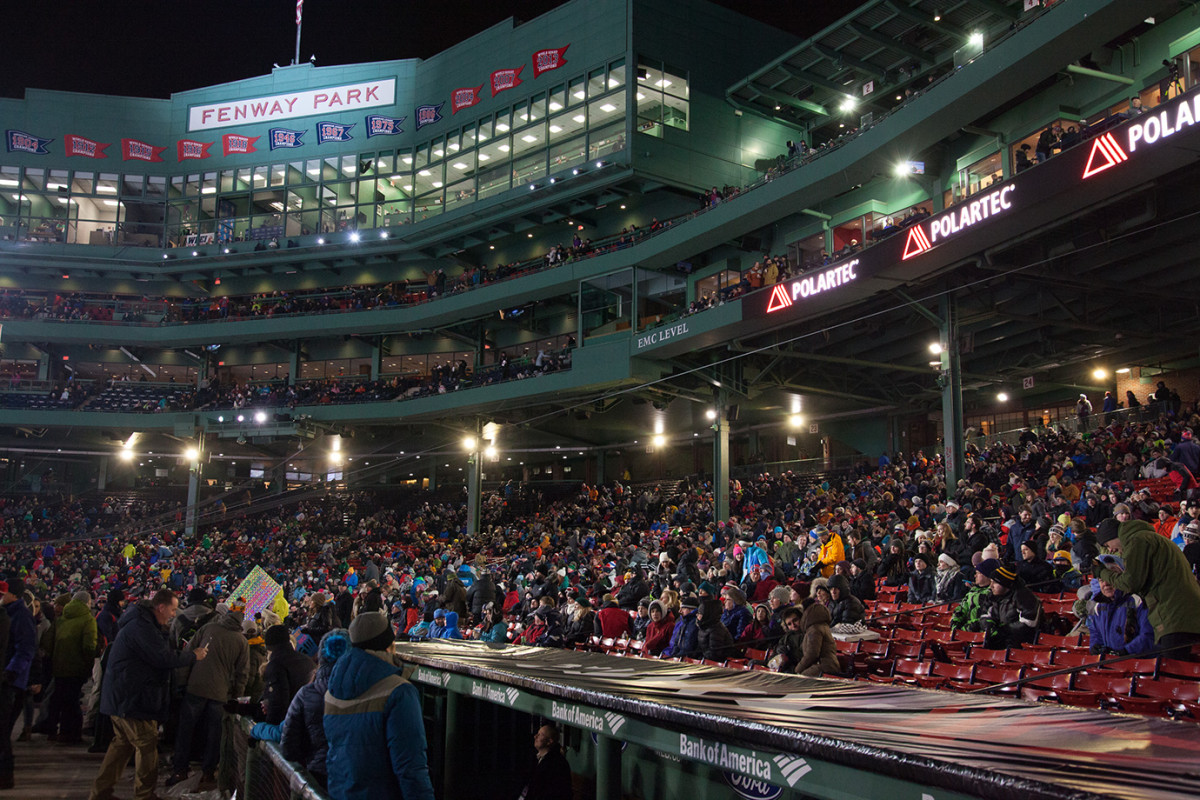
The crowd at Fenway Park grows even larger for the freeskiing competition on Day 2.
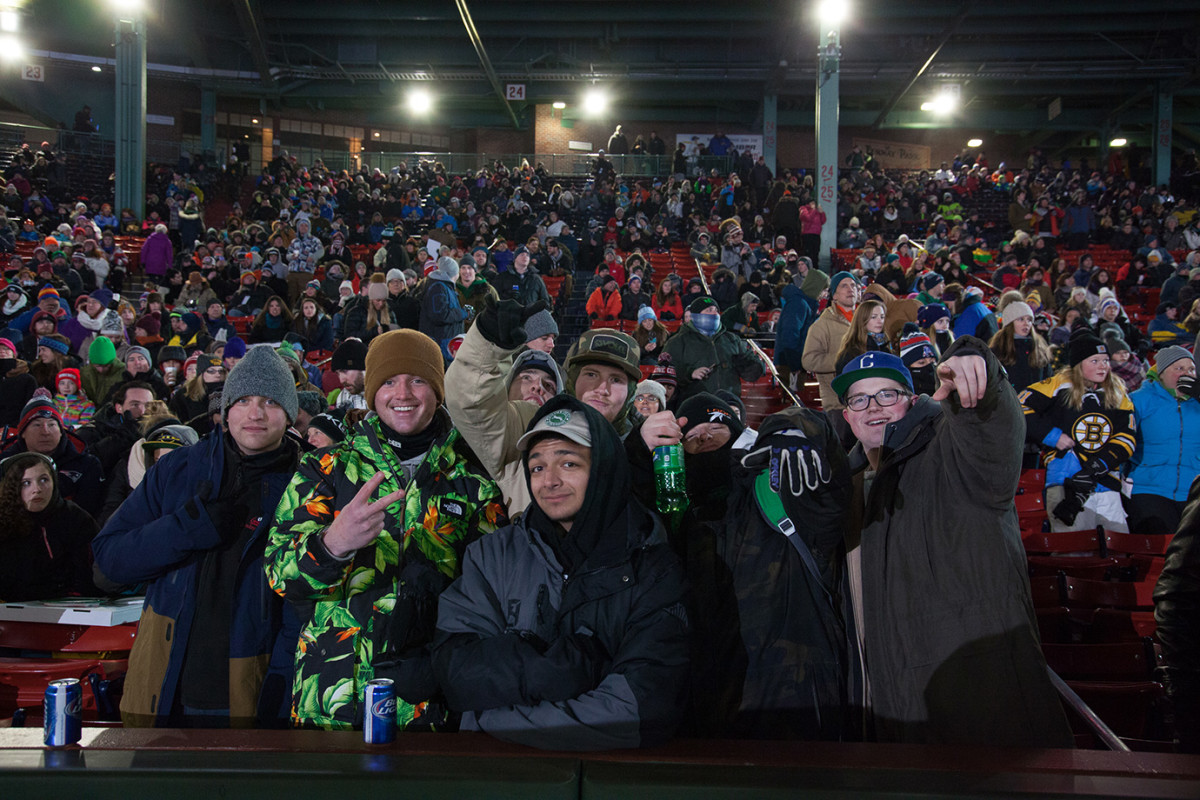
The Boston faithful fill the center of the stadium in anticipation of the skiing Big Air final.
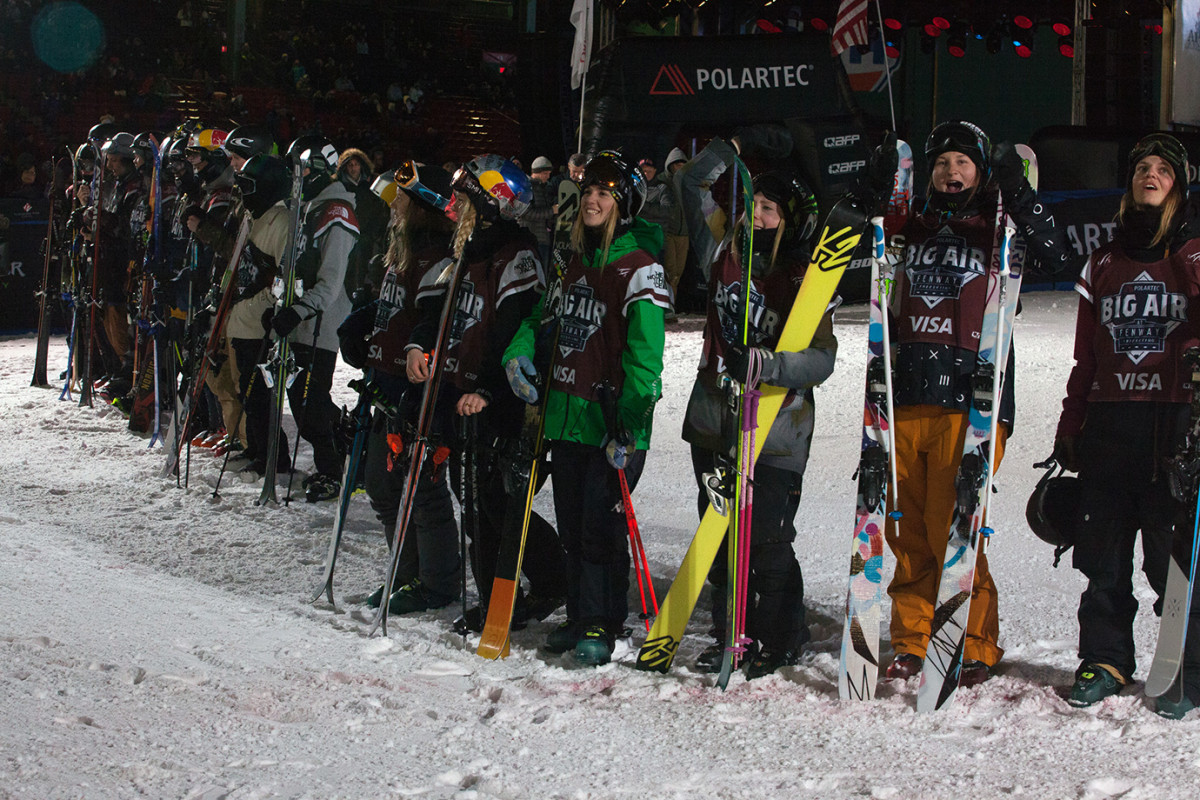
The male and female skiers who qualified for the final assemble at the bottom of the jump for introductions.
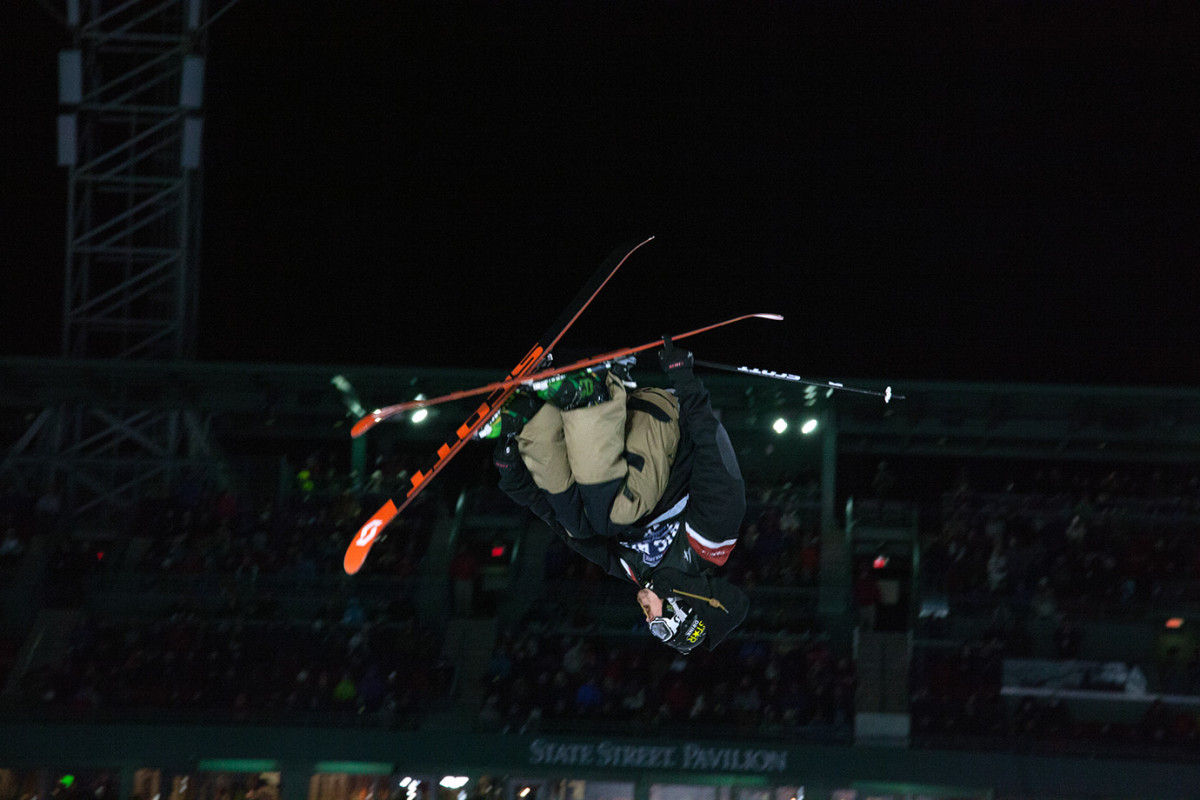
Klaus Finne catches air during the skiing Big Air final.
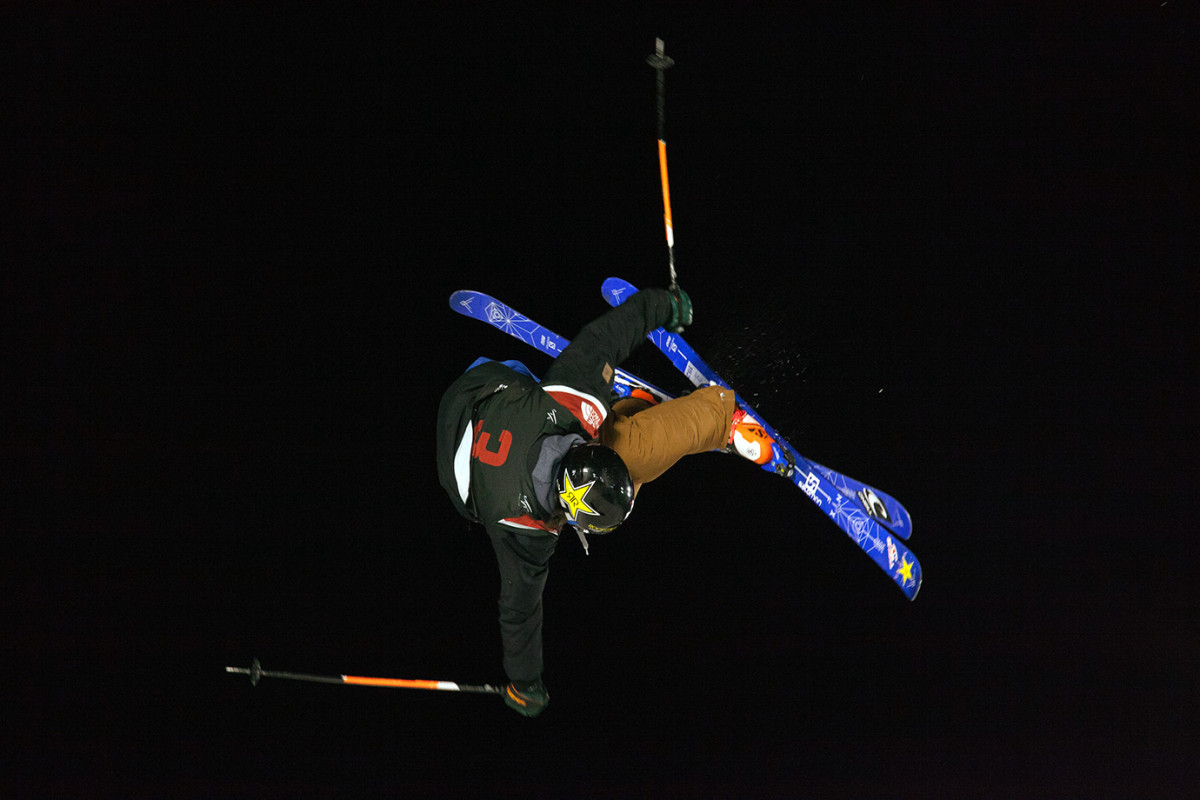
First-place winner Vincent Gagnier during the first of his three high scoring runs.
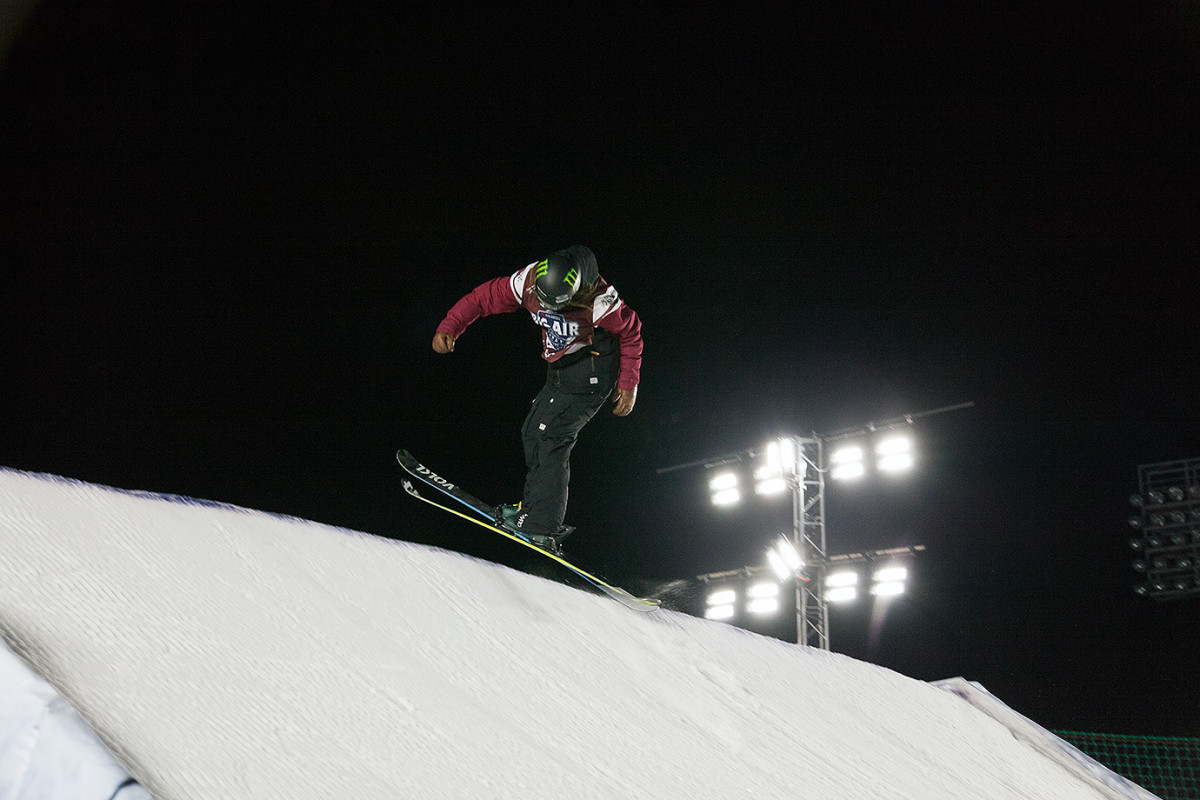
Women’s third-place winner Emma Dahlstrom takes off from the Big Air ramp during the ski final.
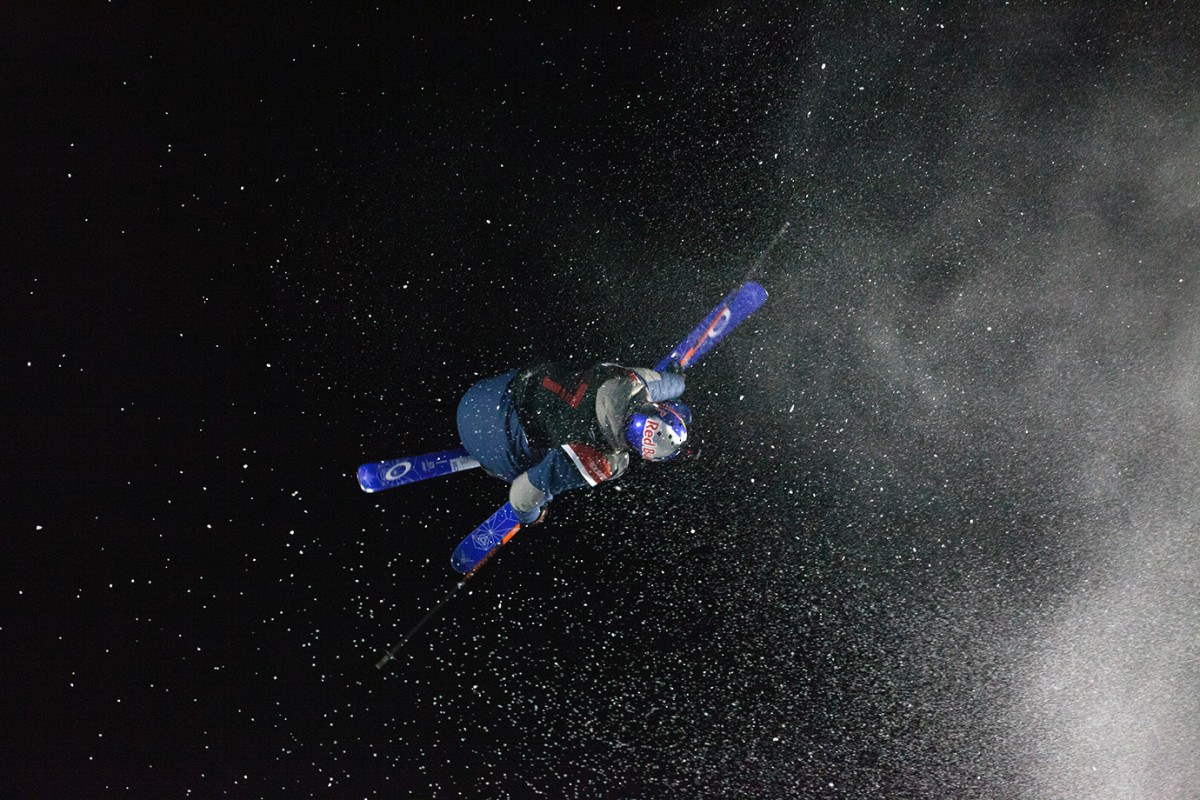
Oscar Wester leaves a trail of powder in his wake during his second run of the Big Air ski final.
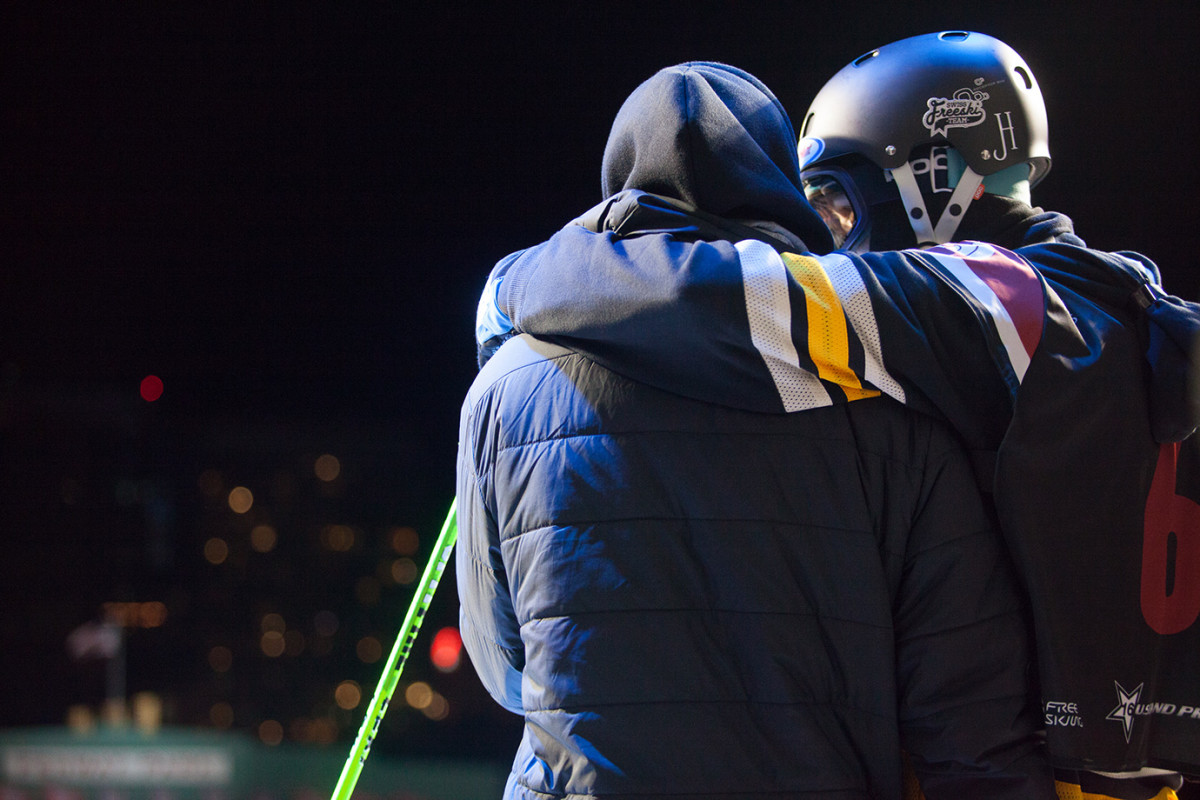
Boston favorite Jonas Hunziker embraces a member of his crew right before his final run.
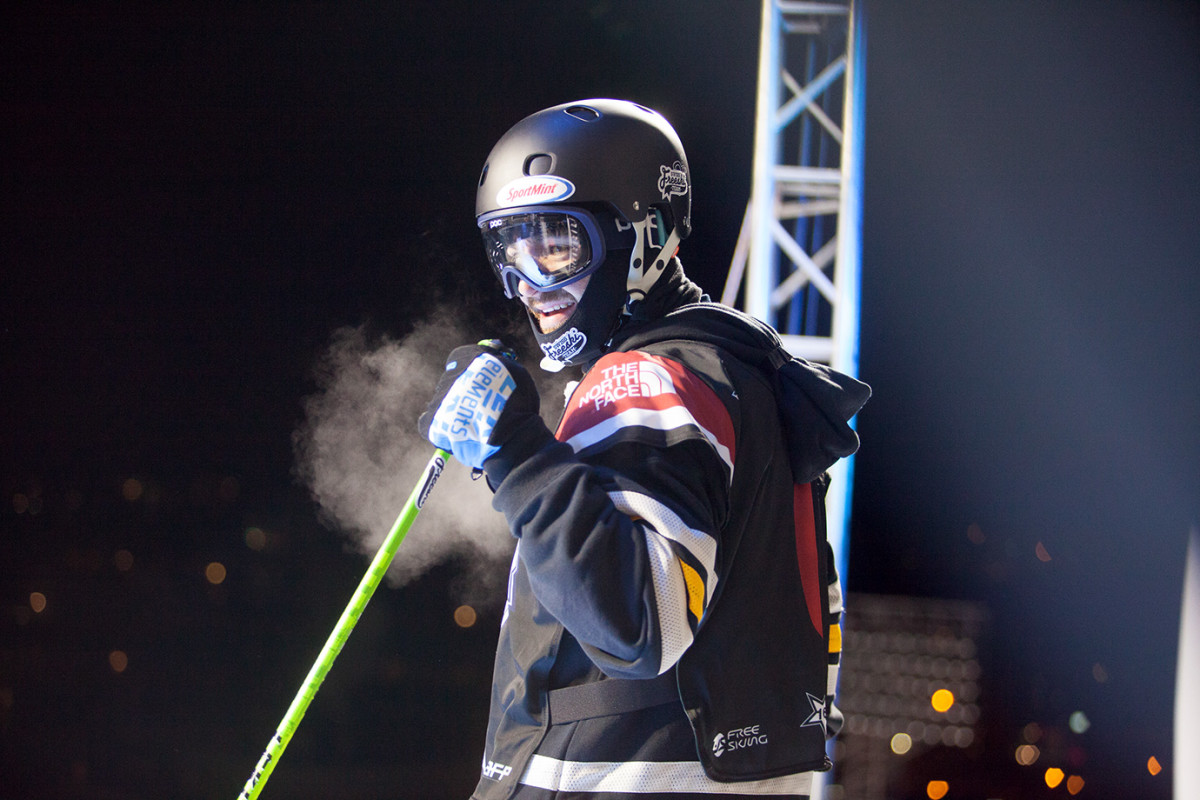
Hunziker, who performed in a Boston Bruins jersey, was all smiles during the moment he took to look down upon Fenway Park before his final run.
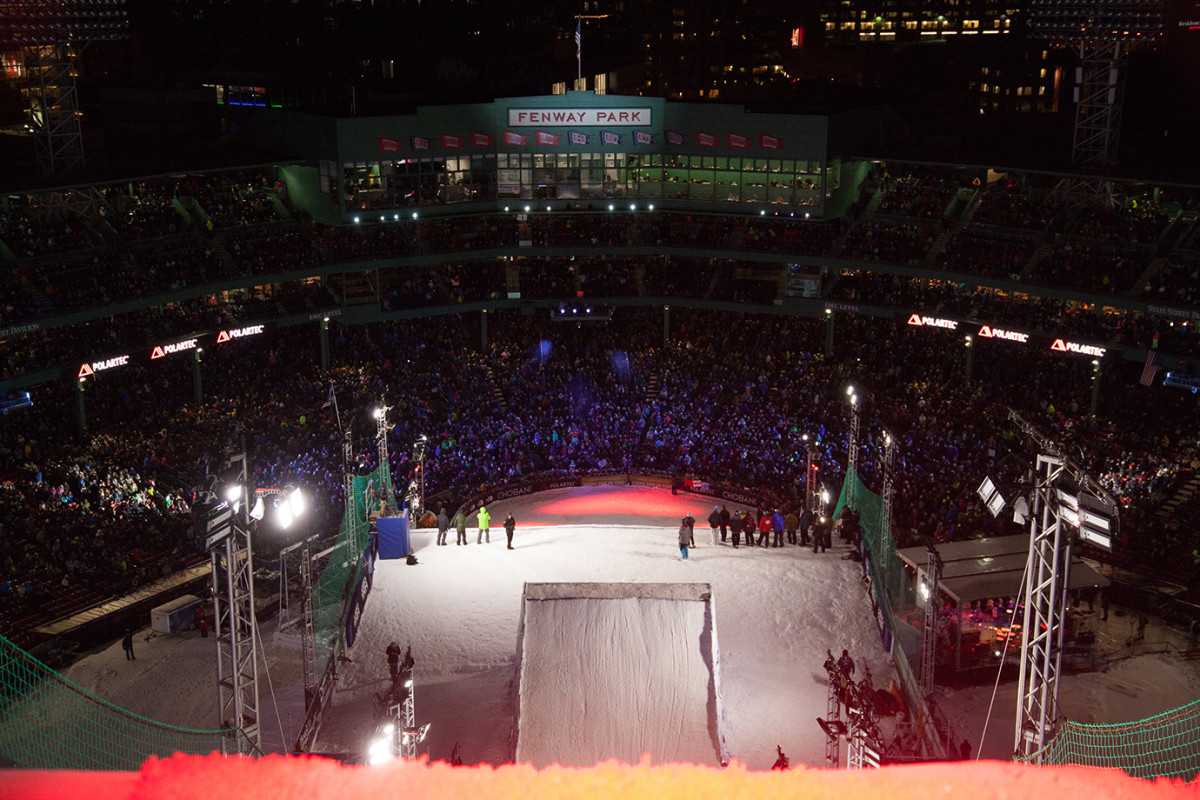
The view of the crowd at Fenway Park from the very top of the Big Air ramp
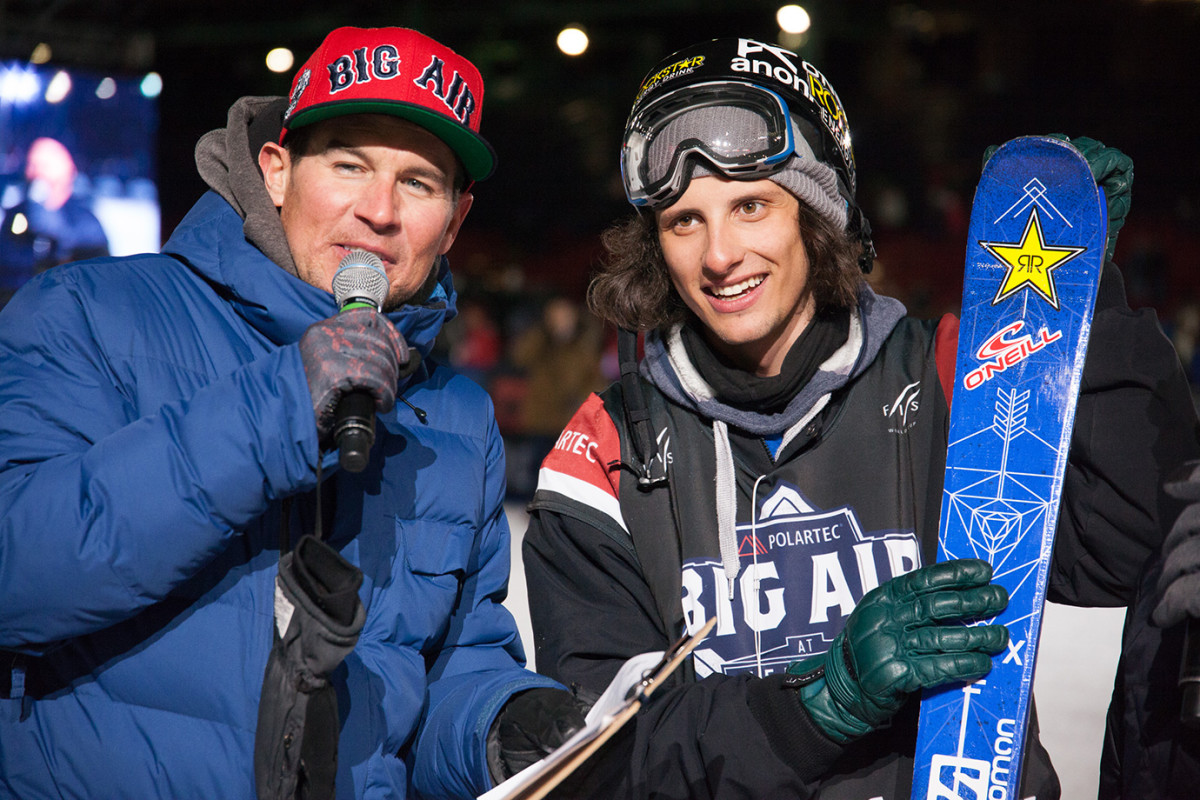
Men’s ski Big Air winner Vincent Gagnier during his interview with Fenway Big Air and X Games field reporter DC.
How would you rank them personally? You’ve had one of the most successful event seasons of your career this year. What has the difference been?
GK: Well, the order definitely goes slopestyle, halfpipe, then big air. I think the key to my success was just focusing on each event individually. I’ve learned that I need to take them on one at a time as they come. In the past, I’ve gotten worked up about slopestyle on the day of the halfpipe event and then not performed in either how I wanted to. I need to focus on whatever event is at hand, whatever I’m competing in that moment. I was able to do that in Aspen and I won silvers in both halfpipe and slopestyle events. Staying in the moment makes all the difference in the world for me.
RW: You didn’t compete in the X Games Big Air competition because you were an alternate, and you pulled out of the Fenway Big Air event to rest your bruised heel. Which event would you have preferred to compete in?
GK: My love of X Games being well documented, I always prefer to compete in good weather. I think the X Games Ski Big Air event was tough for the guys. They couldn’t jump switch, they were having a hard time clearing the jump and visibility wasn’t the best. That makes an event more difficult and dangerous that an unconventional setup. So I think I’d opt for Fenway. But, the X Games jump was a lot bigger. That allows us to throw our best tricks. Fenway was smaller, so it was going to be a scaled down event regardless. The flight distance in Aspen is 70 feet. I heard Fenway was about 46. So that does change things.
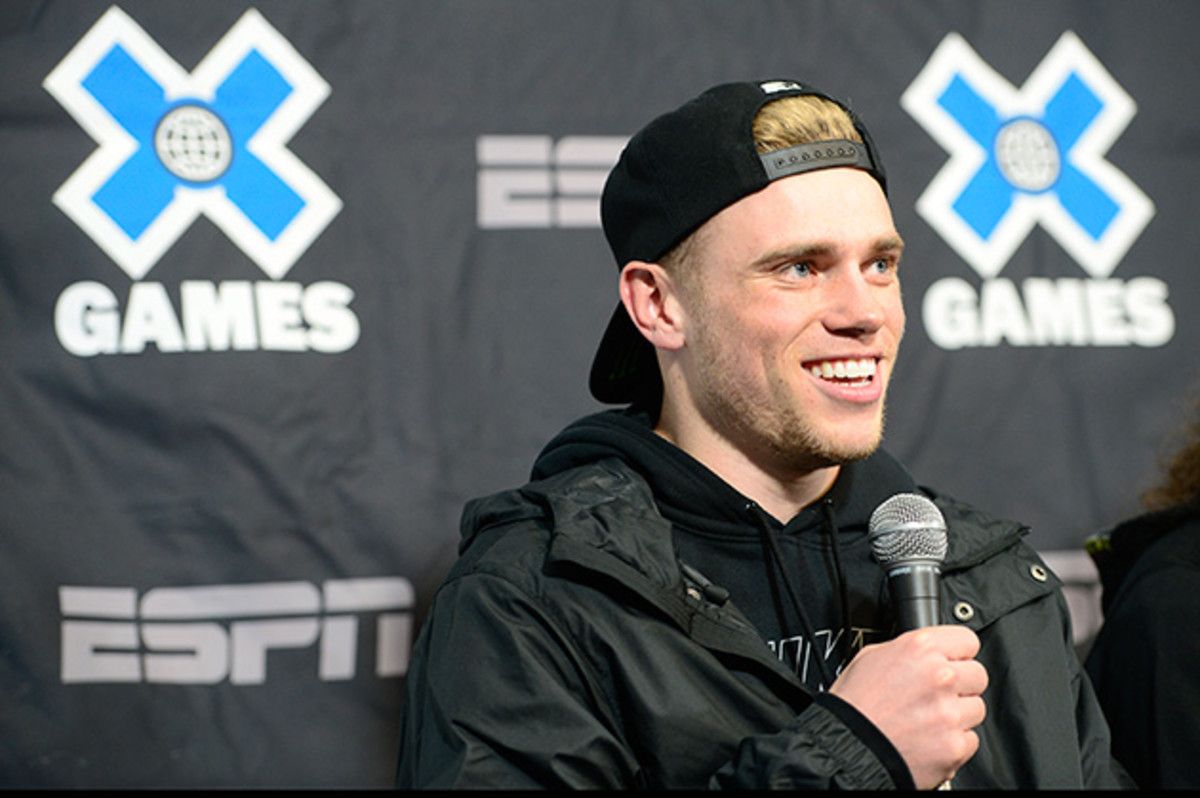
Talk through the genesis of this heel injury that you’ve been dealing with.
GK: I really didn’t have high expectations going into this season because I’d blown my knee at the end of last season and been off of snow for 10 months. I’d only had a couple days of skiing going into Dew Tour. I ended up winning that slopestyle event, but that’s also where I first hurt my heel, so I was just happy to come out of that with the victory. I didn’t ski a day after that until I competed at the U.S. Grand Prix stop in Mammoth without needing an injection. I got a win there and went into X Games with a lot of momentum; I felt I was skiing well even though I wasn’t skiing that much.
Then I bruised the heel again in Aspen just before dropping into the pipe. I made it through that event on adrenaline and a taped up heel, but I had a couple low landings and my heels were on fire afterwards. I didn’t know if I was going to be able to do slopestyle. I was considering pulling out. But after getting the heel numbed, I was able to compete and win my second medal of the weekend. I had to really earn those, so they do mean a lot to me.
2014 Olympic champ Iouri Podladtchikov on the perfect halfpipe
You suffered that heel injury during your win at Dew Tour that also affected you in Aspen, despite your success at both stops. How have you skied so well on it?
GK: The heel definitely didn’t feel very good in Aspen and wasn’t better in Boston. I limited my skiing at X Games to just the days I was competing. I wasn’t doing any practices, just the warm ups before an event and the event itself. The U.S. Ski team doctor was giving me shots in my heel. Cortisone is on the banned substance list, but he was able to give me a numbing solution that took the feeling out of my heel for four hours at a time. That was the only way I could ski. I pulled out of the U.S. Grand Prix Halfpipe event in Park City after X Games hoping to do Big Air Fenway, but it was the same way in Boston. I was on the fence about competing until basically the day of when I decided against it. I opted to rest until X Games Oslo because I didn’t want to compete the rest of the season plagued with this injury.
RW: What’s the most important aspect of your training regimen?
GK: The most important thing for my training is consistency. Because I travel a lot in both the winter and the summer, it can be easy to fall out of my routine whether you’re just going to the gym or going to the gym and skiing. If it’s a travel day, or I’ve skied that day, it’s easy to not want to go to the gym. Maybe I’m in a hotel with a subpar gym and I don’t have access to anything better. There are a million reasons on the road to not do what you know you’re supposed to. The discipline to avoid coming up with excuses and stay on schedule is really important, and tough to grow if it doesn’t come naturally.
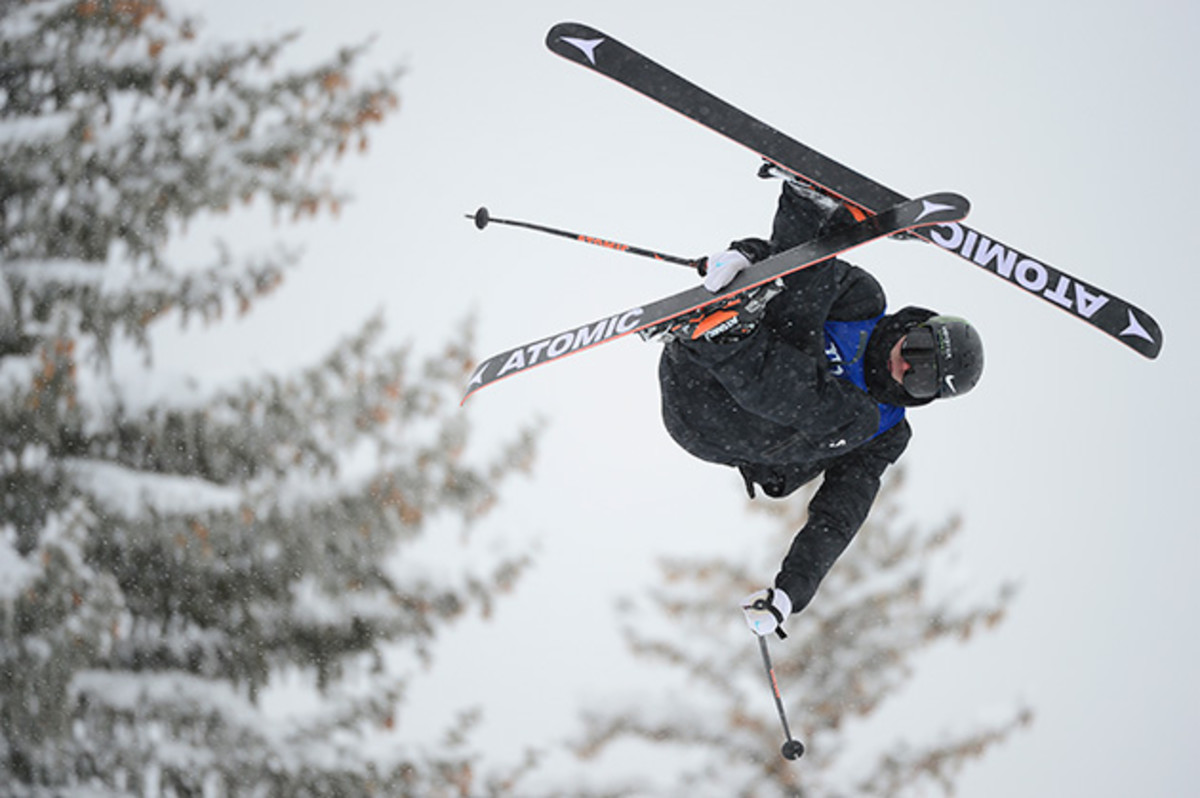
The Fenway event was advertised as a celebration of big air’s inclusion in the 2018 Winter Olympics for snowboarding. What was your reaction to skiing not being included?
GK: I took that [Fenway] event for what it was: an opportunity to ski in a place no one ever had before, in front of an audience that would never see us otherwise. It was one of the first times that we’d had a major ski contest in a downtown metropolitan area. We don’t have X Games or Dew Tour on the East Coast, so it was something new and a cool.
As far as ski big air’s exclusion from the Olympics, I don’t really care all that much. I know a lot of other people are way more upset about it. I do think it’s strange, to build the jump and have the infrastructure in place and not let the skiers use it. We use the same courses for skiing and snowboarding big air, slopestyle and halfpipe. The argument was that skiing already has more events than snowboarding, and that’s valid. But I do hope it gets in eventually.
RW: You said recently that the X Games is as important to you as the Olympics. What about X Games makes it so important?
GK: It’s always been the X Games that I’ve dreamed of winning. Whether that started when I first got there as a pro or when I was watching it on TV as a kid, that’s always been the primary goal for me. The Olympics came into the picture so much later. When it became an option to go to the Olympics, I shifted my focus a little bit to shoot for the Olympics as well. The U.S. podium sweep with Nick and Joss will always be a great memory. But it didn’t change the fact that I want to win at X Games most of all, and it still hasn’t.
The SI Extra Newsletter Get the best of Sports Illustrated delivered right to your inbox
Subscribe
RW: You’ve never won a gold medal at either event. If someone promised you one at the cost of the other, which would you choose?
GK: I guess if it were that, I’d probably take the Olympic medal. It comes once every four years, so I maybe have one more shot at it. From a career standpoint, what it does for your life and your brand and everything like that, the Olympic medal probably counts for more. And of course it’d be amazing to win an Olympic event. But hopefully I don’t have to make that choice. There are so many opportunities to win at X. Now, if you were offering an X Games dynasty or multiple medals against a single Olympic medal, I think I’d opt for the X Games. One on one, I have to go with the five rings, but I’d be frustrated if I ended my career without an X Games gold medal.
